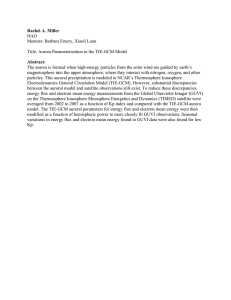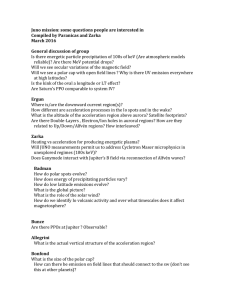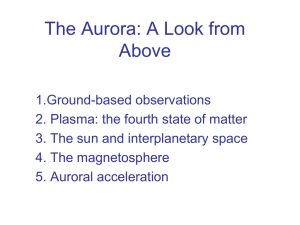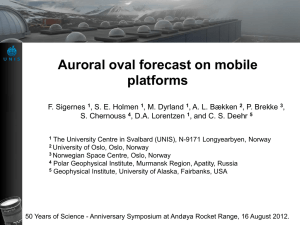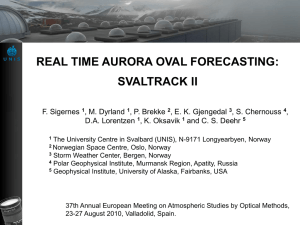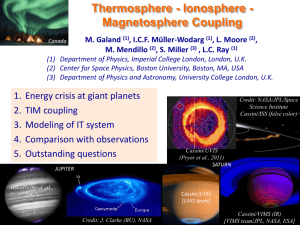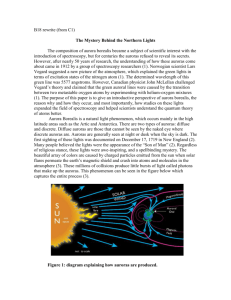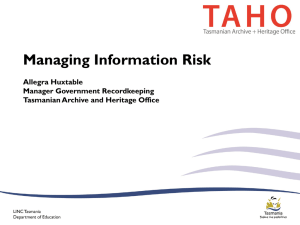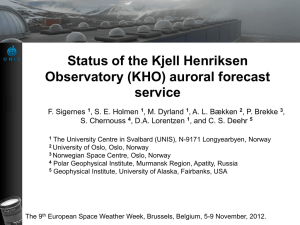Aurora_Lecture15
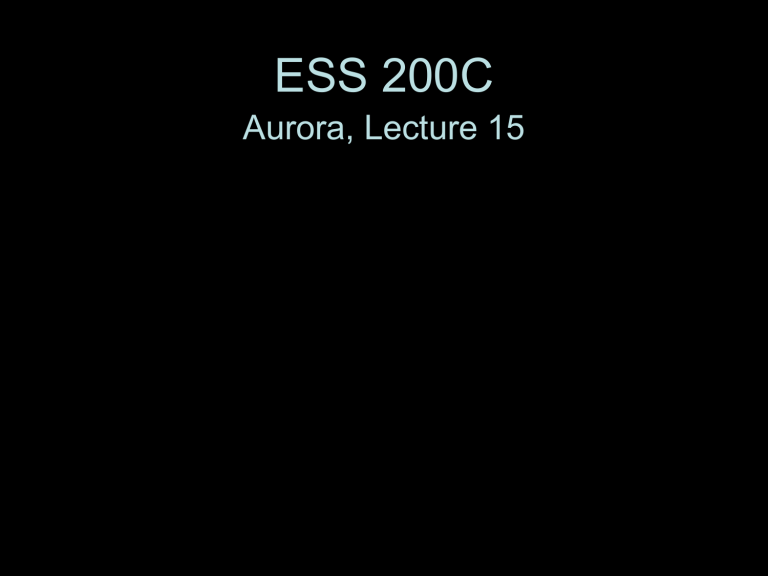
ESS 200C
Aurora, Lecture 15
QuickTime™ and a
DV - NTSC decompressor are needed to see this picture.
1
Auroral Rays
Auroral Rays from Ground Auroral Rays from Space Shuttle
• Auroral emissions line up along the Earth’s magnetic field because the causative energetic particles are charged.
• The rays extend far upward from about 100 km altitude and vary in intensity.
2
Auroras Seen from High Altitude
From 1000 km (90m orbit)
• Auroras occur in a broad latitudinal band; these are diffuse aurora and auroral arcs; auroras are dynamic and change from pass to pass.
From 4R
E on DE-1
• Auroras occur at all local times and can be seen over the
3 polar cap.
Auroral Spectrum
• Auroral light consists of a number discrete wavelengths corresponding to different atoms and molecules
• The precipitating particles that cause the aurora varies in energy and flux around the auroral oval
4
Exciting Auroral Emissions
• Electron impact: e+N→N*+e 1
• Energy transfer: x *+N→x+N*
• Chemiluminescence:
M+xN→Mx*+N
• Cascading: N**→+hν
(N
2
+ )*→N aurora
2
+ +391.4nm or 427.8nm
O( 3 P)+e→O( 1 S)+e 1
O( 1 S)→O( 1 D)+557.7nm (green line)
O( 1 D) →O( 3 P)+630/636.4nm (red line)
• Forbidden lines have low probability and may be deexcited by collisions.
Energy levels of oxygen atom
1 D, t=110 s
5
Auroral Emissions
• Protons can charge exchange with hydrogen and the fast neutral moves across field lines.
• Precipitating protons can excite H α and Hβ emissions and ionize atoms and molecules.
• Day time auroras are higher and less intense.
• Night time auroras are lower and more intense.
• Aurora generally become redder at high altitudes.
6
The Aurora – Colors
QuickTime™ and a
Photo - JPEG decompressor are needed to see this picture.
7
Auroral Forms
Forms
• Homogenous arc
• Arc with rays
• Homogenous band
• Band with rays
• Rays, corona, drapery
• Precipitating particles may come down all across the auroral oval with extra intensity/flux in narrow regions where bright auroras are seen.
• Visible aurora correspond to energy flux of 1 erg cm -2 s -1 .
Nadir Pointing Photometer Observations
8
Height Distribution/Latitude Distribution
• Auroras seen mainly from 95-150 km
• Top of auroras range to over
1000km
• Aurora oval size varies
– from event to event
– during a single substorm
9
Polar Cap Aurora
• Auroras are associated with field-aligned currents and velocity shears.
• The polar cap may be dark but that does not mean field lines are open.
• Polar cap aurora are often seen with strong interplanetary northward magnetic field
10
Auroral Substorm
Model based on ground observations Pictures from space
• Growth phase – energy stored
• Onset – energy begins to be released
• Expansion – activity spreads
11
Auroral Currents
•
If collisions absent then electric field produces drift perpendicular to
β.
•
When collisions occur at a rate similar to the gyrofrequency drift is at an angle to the electric field j
1
2
0
1
2
0
0
0
0
E
E y
E x z
•
• If B along Z and conductivity strip along x, we may build up charge along north and south edge and cut off current in north-south direction.
If j y
0 ,
2
E x
1
E y
0 and j x
(
1
2
1
2
) E x
•
Called the Cowling conductivity
12
Magnetosphere Ionosphere Coupling
• Magnetosphere can transfer momentum to the ionosphere by field-aligned current systems.
• Ionosphere in turn can transfer momentum to atmosphere via collisions.
• Magnetosphere can heat the ionosphere.
• Magnetosphere can produce ionization.
• Ionosphere supplies mass to the magnetosphere.
• Process is very complex and is still being sorted out.
13
Force Balance - MI Coupling
j = ne ( U i
–
U e
)
14
Drivers of Field-Aligned
Currents
Plasma momentum equation – force balance – leads to a fundamental driver of field-aligned currents.
Following Hasegawa and Sato [1979], and D. Murr, Ph. D. Thesis
“Magnetosphere-Ionosphere Coupling on Meso- and Macro-Scales,” 2003:
B•
j
•B
B
2
= 2
B•
P
B
B
3
+ 1
B
2
+
B
2
B
B• d w dt d U dt
•
V
A
2
V
2
A
w • d B dt
Vasyliunas’ pressure gradient term
Inertial term
Vorticity dependent terms ( w U )
Assumptions:
• j = 0, E + U x B = 0 . Hasegawa and Sato [1979] and Murr
[2003] assumed vorticity w || B .
15
Maxwell Stress and Poynting Flux
16
Currents and Ionospheric Drag
17
Weimer FAC morphology
18
FAST Observations
IMF B y
~ -9 nT.
IMF B z weakly negative, going positive.
19
MHD FAST Comparisons
20
MHD FACs
21
Three Types of Aurora
Auroral zone crossing shows:
Inverted-V electrons (upward current)
Return current (downward current)
Boundary layer electrons
(This and following figures courtesy
C. W. Carlson.)
22
Upward Current – Inverted V Aurora
23
Downward Current – Upward Electrons
24
Polar Cap Boundary – Alfvén Aurora
25
Primary Auroral Current
Inverted-V electrons appear to be primary (upward) auroral current carriers.
Inverted-V electrons most clearly related to large-scale parallel electric fields – the “Knight” relation.
26
Current Density – Flux in the Loss-Cone
The auroral current is carried by the particles in the loss-cone.
Without any additional acceleration the current carried by the electrons is the precipitating flux at the atmosphere: j
0
= nev
T
/2 p 1/2 ≈ 1 m A/m 2 for n = 1 cm -3 , T e
= 1 keV.
A parallel electric field can increase this flux by increasing the flux in the loss-cone. Maximum flux is given by the flux at the top of the acceleration region ( j
0
) times the magnetic field ratio
(flux conservation - with no particles reflected).
j m
= nev
T
/2 p 1/2 ( B
I
/ B m
).
27
Knight Relation j / j
0
1 +e / T
The Knight relation comes from Liouville’s theorem and acceleration through a field-aligned electrostatic potential in a converging magnetic field.
Asymptotic
Value =
B
I
/ B m
Does not explain how potential is established.
e / T
[Knight, PSS, 21, 741-750, 1973; Lyons, 1980]
28
Phase Space Mapping
Theoretical and Observed Distributions
(Ergun et al., GRL, 27, 4053-4056, 2000)
Acceleration Ellipse and Loss-cone Hyperbola
29
Numerical Results – Double Layers
Static Vlasov-Poisson simulations
(Ergun et al., GRL, 27, 4053-4056,
2000).
Two sheaths are present:
Low altitude to retard secondaries;
High altitude to reflect magnetospheric ions.
“Trapped” electrons appear to be an essential component.
Hull et al. [JGR, 108, p. 1007, 2003] present statistics of large amplitude electric fields observed at Polar perigee.
Their interpretation of the E
|| being related to an ambipolar field is consistent with the picture shown here.
30
-1x10 5
-5x10
4
Auroral Kilometric Radiation -
Horseshoe Distribution
Electron Distribution in
Density Cavity
-12.0
Upgoing to
Magnetosphere
-13.4
2
3
0
Loss Cone
1
-14.9
Energy Flow
1. Acceleration by Electric Field
2. Mirroring by Magnetic Mirror
3. Diffusion through Auroral Kilometric Radiation
5x10
4
1x10
5
-1x10 5
-16.3
-5x10
4
0
Parl. Velocity (km/s)
Downgoing to
Ionosphere
5x10
4
1x10 5
-17.8
Strangeway et al., Phys. Chem.
Earth (C), 26, 145-149, 2001.
31
AKR Fine Structure
Pottelette et al. [JGR,
106, 8465-8476, 2001;
Nonlinear Processes in
Geophysics, 10, 87 –92,
2003] discuss AKR fine structure as caused by small scale-size elementary radiation sources (ERS). Figure from Pottelette et al.,
2003.
Pottelette and Treumann
[GRL, 32, L12104, 2005] provide evidence of electron holes in the upward current region.
Presumed to correspond to the ERS.
32
Return Current
Return current carried by upgoing electrons.
Distributions heavily processed by wave-particle interactions.
Boundary layer distributions may be associated with Alfvén waves (see later).
The upward electron drift velocity will exceed the electron thermal speed. Wave-particle interactions are likely to become significant. The return current region should therefore be turbulent, with considerable structure in the electron distribution.
33

